- About
- Discover EaseUS
- Reviews & Awards
- License Agreement
- Privacy Policy
- Student Discount
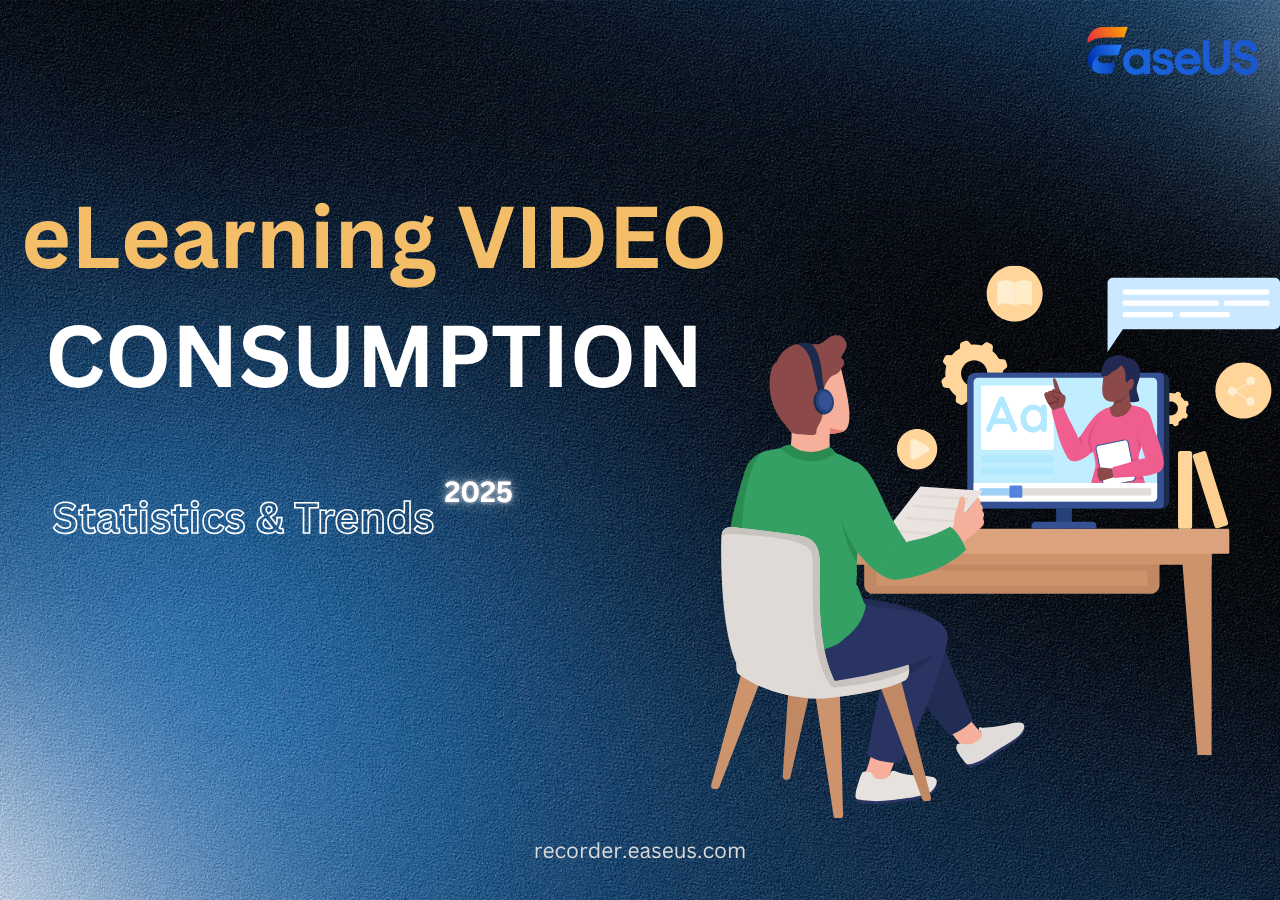
By mid-2025, educational video has become a mainstream medium for learners across all backgrounds. From students and professionals to freelancers and lifelong learners, more people are turning to video to acquire knowledge and skills, driving the deep integration of online learning into everyday life.
This shift is powered by the rapid growth of digital learning platforms and the continuous evolution of content formats. Long-form and short-form videos now coexist, meeting the needs of both structured and bite-sized learning. At the same time, AI and interactive technologies, such as automatic subtitles, video summarization, and embedded quizzes, are enhancing the efficiency and experience of video-based education. Platforms like YouTube, TikTok, Coursera, and Udemy are emerging as primary learning hubs, where the line between education and entertainment is increasingly blurred.
Against this backdrop, this report, produced by the EaseUS Team, draws on platform data and user insights from 2024 through early 2025. It offers an in-depth analysis of educational video trends, platform landscapes, user behaviors, and technological advancements. Whether you're an educator, content creator, or platform innovator, this report aims to equip you with the insights needed to navigate the evolving world of video-driven learning.
1. E-Learning Video Growth Overview
To thoroughly analyze the development trend of the e-learning industry, this section will examine e-learning's overall growth and the drivers of educational video growth. By examining key data such as market size and growth rate, and exploring the reasons why online educational video has become a mainstream learning medium, we aim to clarify the industry's development path and offer valuable insights to practitioners and observers.
1.1 Overall Growth of the eLearning Industry
Driven by the widespread adoption of the internet, the global online learning market has been steadily increasing in size.
According to data from The Business Research Company, the report shows the global online learning market reached USD 314.03 billion in 2024, with projections indicating growth to USD 354.71 billion in 2025 (a 13.0% year-on-year increase). The eLearning video market is expected to maintain strong growth momentum, reaching an estimated USD 625.3 billion by 2029, representing a 15.2% compound annual growth rate (CAGR) from 2024 to 2029.
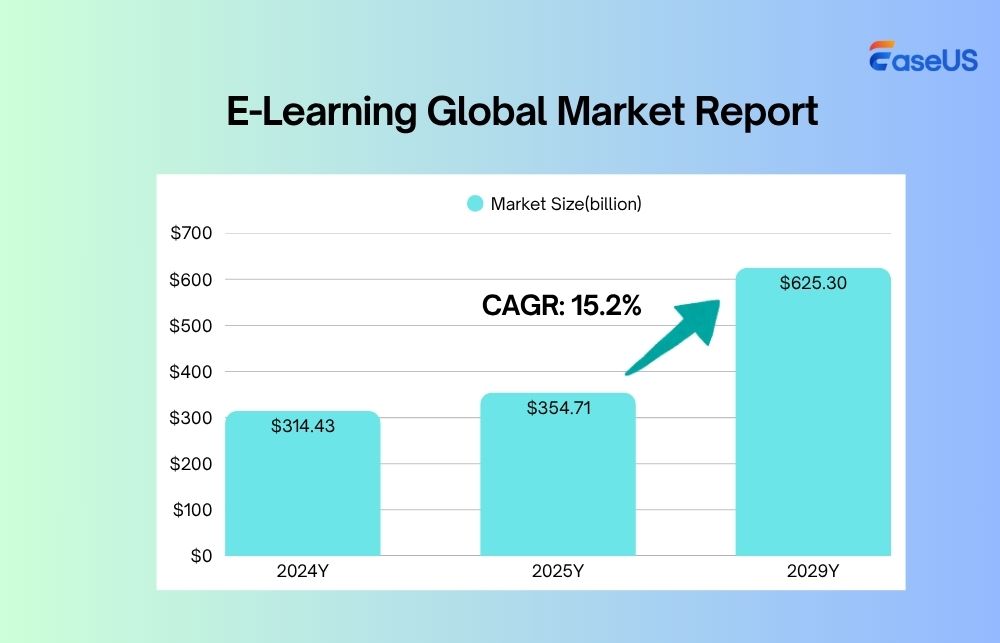
Found this report insightful? Share it with your peers and spark the conversation.
1.2 Drivers of eLearning Videos Growth
The e-learning industry is experiencing significant growth, driven by a variety of factors that are transforming the landscape of digital education. These drivers include:
✅Technological Advancements
- Infrastructure upgrades: The widespread adoption of 5G and broadband ensures smooth access to high-definition videos, making learning possible anywhere. For example, by the end of 2024, 58% of the global population (4.7 billion) will be connected to mobile internet, up from 2.2 billion in 2015. (GSMA)
- AI and Machine Learning: These technologies offer personalized learning paths and AI tutors, making education more tailored and efficient.
- Mobile Learning: Mobile devices let people access digital learning video resources anytime, anywhere, especially in regions with high smartphone use. Per beardedskeptic's report, the m-learning market stood at $140.4 billion in 2024 and is forecasted to hit $388 billion by 2030, growing at a CAGR of 18.5%. (Bearded Skeptic)
- VR and AR: These immersive techs create interactive learning environments for sectors like healthcare and corporate training. Interactive video eLearning, enhanced with AI technology, offers a highly engaging and personalized educational experience.
✅Increasing Demand for Continuous Learning
- Skill Development: In a changing job market, eLearning platforms help people update their skills at their own pace.
- Professional Training: Rapidly growing industries like IT and data science see a surge in eLearning enrollments.
✅Global Reach and Accessibility
- Breaking Geographical Barriers: The internet allows global access to educational content, reaching remote areas.
- Diverse Learning Environment: Online learning video offers inclusive opportunities for those limited by traditional settings.
✅Video as a Mainstream Learning Medium
- Video-Based Learning: Video's engaging nature makes it a top eLearning medium across various sectors.
- AI-Enhanced Video: AI boosts video accessibility with features like transcription and captioning.
✅Corporate Training and Development
- Investment in Skills: Companies use eLearning for cost-effective employee training, from onboarding to professional development.
- Blended Learning: Combining online and traditional education gains popularity in K12 and higher education.
✅Government and Policy Support
- Digital Infrastructure: Governments invest in digital infrastructure to expand eLearning, like India's Digital India initiative.
- Policy Initiatives: Policies like the EU's Digital Education Action Plan(2021-2027) promote eLearning adoption.
✅Microlearning and Gamification
- Microlearning: Small, manageable content chunks suit busy professionals needing quick learning solutions.
- Gamification: Adding game elements to learning platforms boosts engagement and retention.
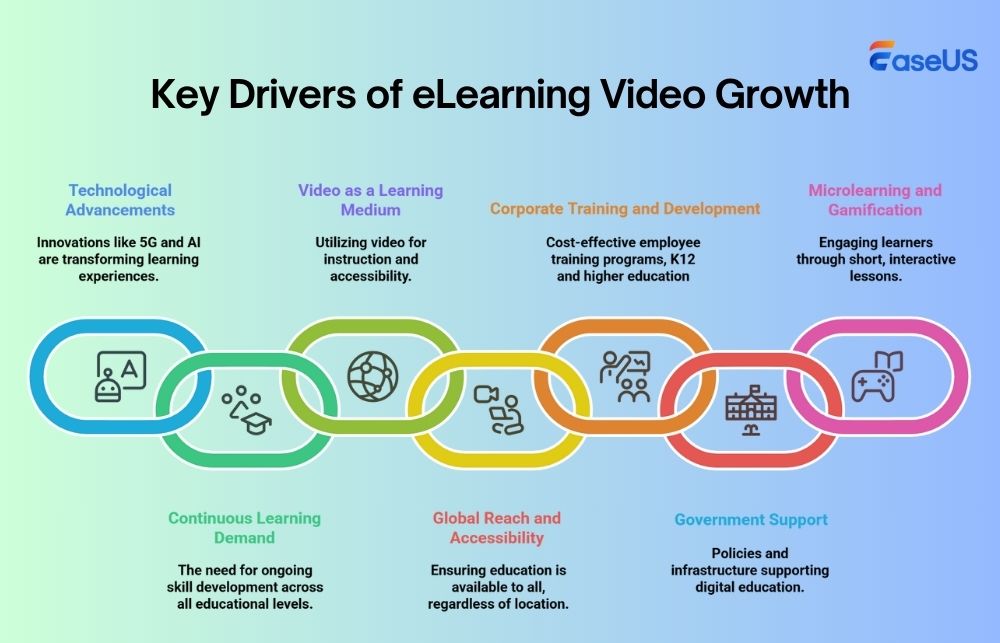
Insights like these are better when shared. Spread the knowledge.
2. Video-Based eLearning Platform Landscape
This section explores the eLearning Platform Landscape, analyzing mainstream platforms, their market share, and key content trends.
2.1 Mainstream Online Learning Platforms Analysis
Here's a summary of mainstream online learning platforms, covering both long-form and short-form video platforms, their introductions, learning content, and formats. These mainstream eLearning platforms and content formats offer a wide range of educational resources, catering to different learning styles and needs.
| Platform | Content | Format | Overview |
|---|---|---|---|
| Coursera | Top university and company courses in tech, business, humanities, and health | Free auditing, specializations, degree programs, short-term certs | Leading platform for high-quality courses and certifications |
| Udemy | Diverse courses in tech, business, and personal development | Self-paced learning with interactive forums | Skill enhancement in various fields |
| LinkedIn Learning | 23,000+ courses for business, technical, creative skills, and personal development | Diverse resources (videos, quizzes, micro tips) | Focuses on professional skills and career advancement |
| MasterClass | Expert-taught courses in arts, cooking, writing, music | High-quality video courses with interactive elements | Specializes in creative skills taught by industry experts |
| YouTube | Broad educational content across multiple subjects | Short, engaging videos for quick learning | Go-to platform for educational content |
| TikTok | Educational content on various themes | Short, interactive videos | Ideal for quick, engaging learning |
| Life skills, health, creativity | Brief, shareable videos | Perfect for quick learning and sharing |
Source: Coursera, Udemy, LinkedIn, YouTube, Blogging Wizard, etc.
2.2 eLearning video Platform Market Size
By verifying the annual data reports of each platform or the data from professional data testing agencies such as Statista, we have summarized the following information on the user size of each online video education platform.
- Coursera boasts a user base of 175 million, and the revenue of Coursera in 2024 amounted to $694.67 million, offering approximately 10,000 courses. (Coursera)
- Udemy has a user base of 79 million. Its revenue for the full year of 2024 was $786.565 million, providing over 250,000 courses. (Business Wire)
- LinkedIn Learning, with a user base of 79 million, offers more than 22,000 courses. The total platform revenue was $16.37 billion in 2024. (DemandSage)
- Duolingo has 48.6 million users and generated $748 million in revenue in 2024, offering over 100 courses. (Duolingo)
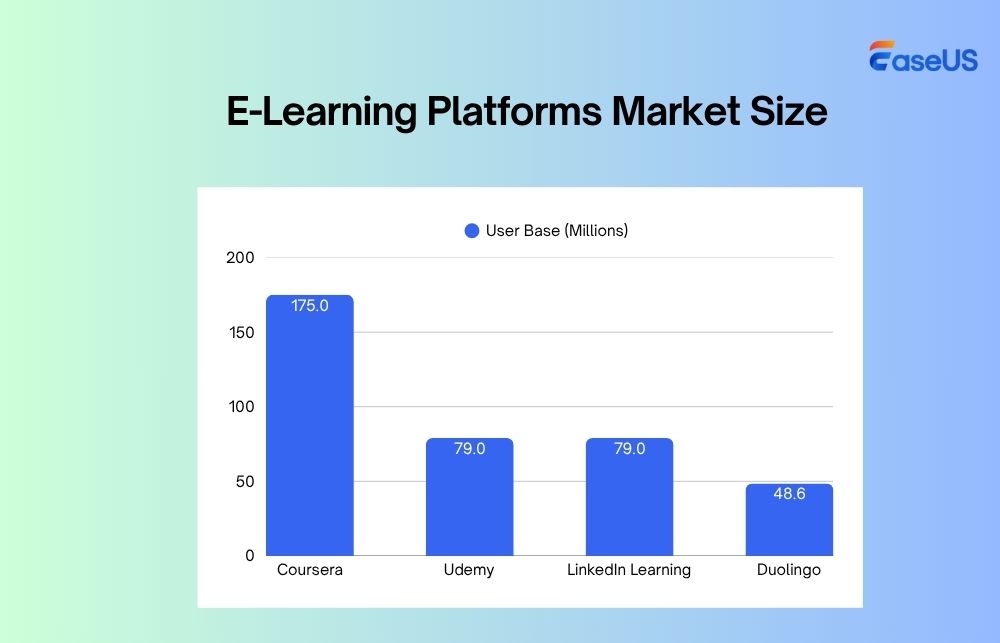
Meanwhile, amid the global surge of short-form video content, platforms like YouTube, TikTok, and Instagram are rapidly emerging as influential tools for online education. With massive user bases, high engagement rates, and a natural fit for fragmented learning, these online video learning platforms are quietly reshaping how people access and consume knowledge, making learning more efficient, flexible, and diverse.
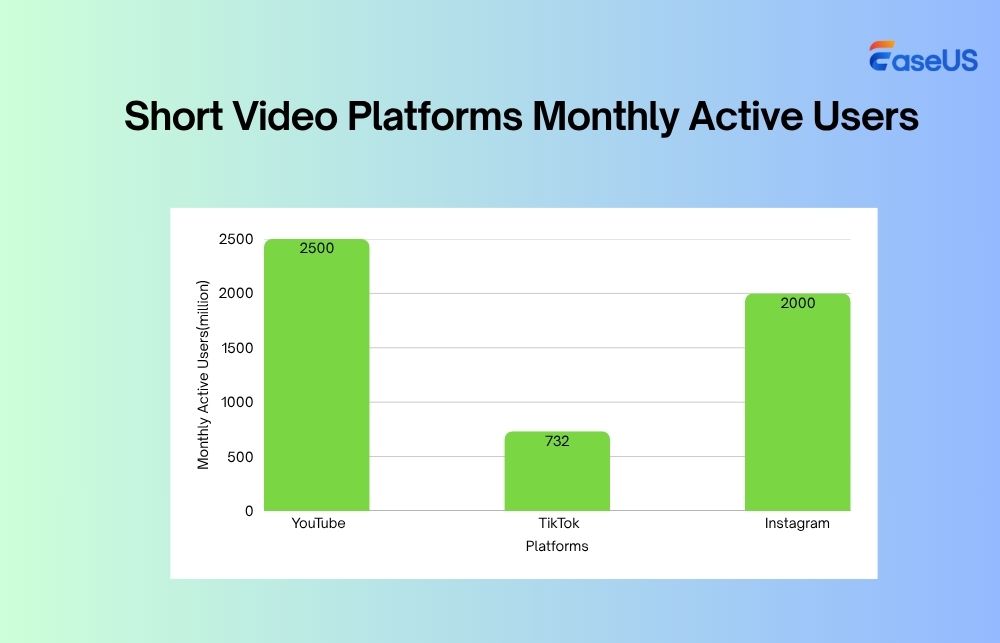
Help others stay ahead, and share this data-driven insight with your network.
2.3 e-Learning Video Platform Content Trends
As e-learning continues to evolve, content formats and production styles are becoming key differentiators in learner engagement and effectiveness. The forthcoming significant trend in online video eLearning platforms will focus on striking the right balance between content duration and the way sources are molded. This evolution extends beyond the mere presentation of knowledge; it encompasses the entire process of knowledge creation and the overall learning experience.
✅Long-Form vs Short-Form Online Videos: Fragmented Learning vs Systematic Learning
Leading online education platforms are moving toward content convergence and enhanced technological applications. The integration of long-form and short-form video platforms is advancing, combining systematic and fragmented learning strengths to provide more versatile and enriched experiences.
Meanwhile, advancements in artificial intelligence, big data, and virtual reality are enabling highly personalized and immersive learning journeys. Coursera exemplifies this trend with its innovative tools like course builders, interactive dialogues, and role-playing scenarios, empowering educators to create bespoke and engaging learning experiences tailored to their audience's unique needs.
✅UGC vs PGC: Balancing Diversity and Professionalism
In the field of online video, UGC(User-Generated Content) is known for its diversity and personalization, allowing users to share unique insights and experiences. For example, on educational video platforms, UGC can be learning tips videos, experience sharing, or course feedback shared by learners, which increases the interactivity and community feel of the platform.
In contrast, PGC(Professionally Generated Content) is characterized by its professionalism and high quality, produced by experts to ensure accurate and reliable information. It is ideal for learners seeking in-depth knowledge in specific subjects. PGC is manifested in course videos, lectures, or tutorials produced by certified teachers or industry experts. These contents are rigorously structured and designed to provide a systematic learning experience.
The integration of UGC and PGC not only enriches the content library but also promotes the vitality of the learning community and makes online video education more flexible and effective.
3. Audience Insights for Educational Video
This section explores the audience behind educational video consumption, combining general platform demographics with insights from learning-focused platforms. It presents a clear picture of how different age groups and professional segments engage with educational content.
3.1 Learning-Oriented Audience Segments
Educational video consumption now serves diverse groups with different needs - students focus on academic success, professionals prioritize upskilling, and creators learn to monetize skills. This shift highlights how video has become a core tool for learning, career growth, and productivity beyond traditional classrooms.
✅Students (K-12 & Higher Education)
Students rely on educational videos for exam prep, concept reinforcement, and visual learning. They prefer short, engaging content from YouTube, TikTok, and MOOCs like Coursera and edX.
✅Technical Professionals (Software, Data, AI)
This group drives the highest demand for video learning, balancing in-depth courses on Coursera and Udemy with quick problem-solving tutorials on YouTube. Their focus is on coding, AI, cloud, and fast-paced upskilling.
✅Business, Marketing, and Management Professionals
Focused on skills like leadership, AI, coding, and communication. They rely heavily on LinkedIn Learning, Coursera, and YouTube long-form tutorials. Notably, 48% of LinkedIn Learning users engage with content weekly. (SocialPilot, 2025)
✅Freelancers and Creators
Freelancers learn video editing, design, SEO, and monetization strategies via YouTube, Skillshare, and TikTok. Their learning is fast, project-based, and directly tied to content creation and income growth.
✅Job Seekers and Lifelong Learners
This group seeks flexible, affordable learning for career shifts or personal growth. They favor free resources like YouTube and structured MOOCs like edX and Coursera for credential-based learning.
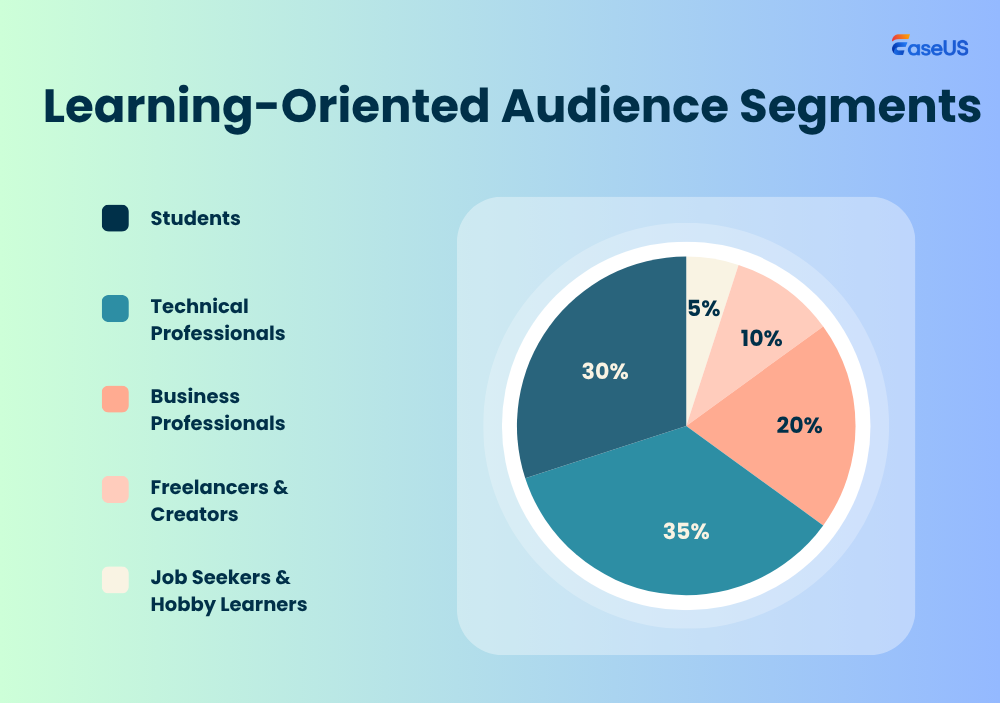
The distribution is an aggregated estimation based on data from LinkedIn Learning, Coursera, Udemy, and Pew Research.
3.2 Platform-Level Audience Overview
Video consumption, including educational content, is deeply ingrained in daily life across generations. Platform usage by age group is as follows (According to Pew Reaserch Center):
- YouTube continues to dominate across all age groups, especially among those aged 18–49.
- TikTok sees heavy adoption among Gen Z and younger Millennials, but drops sharply in older groups.
- LinkedIn Learning serves primarily working professionals aged 25–44 focused on upskilling.
These figures highlight that both entertainment-driven (TikTok, YouTube Shorts) and knowledge-driven (YouTube long-form, LinkedIn Learning) platforms play critical roles in modern learning ecosystems.
3.3 Audience Behavioral Patterns
Learners are transitioning from passive viewers to active participants in their learning process. This shift is characterized by:
- Playback Speed Adjustment: 83% of college students prefer faster playback, with 53% finding 1.25x–2x optimal. (SpringerLink, 2024)
- Most Popular Speeds: 1.5x is the most used, followed by 2x and 1.25x. Some prefer 1.1x for precision. (YouTube Official Blog, 2022)
- Microlearning Adoption: Microlearning has an 80% completion rate, far surpassing traditional long-form courses at 20%. (Vouch , 2024)
- Behavioral Features: Frequent use of timestamp navigation, offline saving, note-taking alongside videos, and even recording or clipping content for personalized workflows.
- Creation-Driven Learning: Many learners repurpose video content — adding commentary, summarizing, or sharing within study groups.
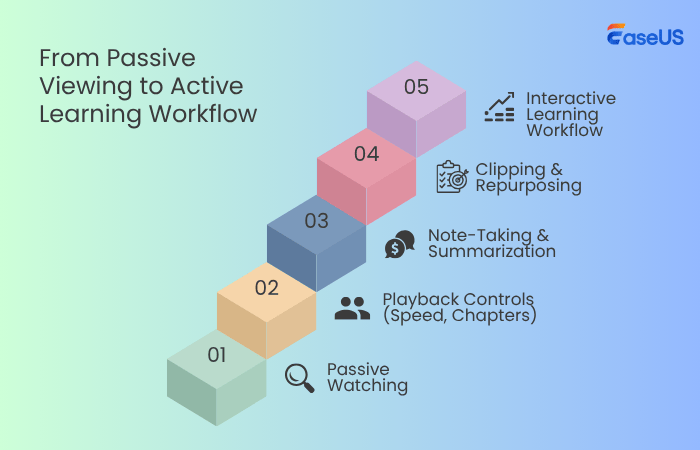
The boundaries between learning and content creation are dissolving. Users expect video-based learning to be searchable, interactive, and modular, moving beyond simple consumption.
If this helped you, it'll help others—share it now and make an impact.
4. Consumption Behavior Trends
As the consumption of educational video continues to evolve, learners are moving toward more flexible, interactive, and productivity-driven formats. This section analyzes how both open video platforms (e.g., YouTube, TikTok) and structured online learning platforms (e.g., Coursera, Udemy, Skillshare) are shaping these behavioral shifts.
4.1 Macro Consumption Patterns: Short vs. Long-Form Video
✅Short-Form Video Dominance in Classrooms
Short-form educational content remains a cornerstone in K-12 and higher education settings.
In fact, 99% of U.S. teachers incorporate short-form videos into their classrooms to enhance engagement, satisfaction, and learning outcomes. Research also indicates that video length has a strong impact on completion rates:
Videos under 6 minutes achieve 100% completion, while those around 9 minutes drop to 60%, and videos extending to 12 minutes see completion rates fall to just 20%. (AXD Agency)
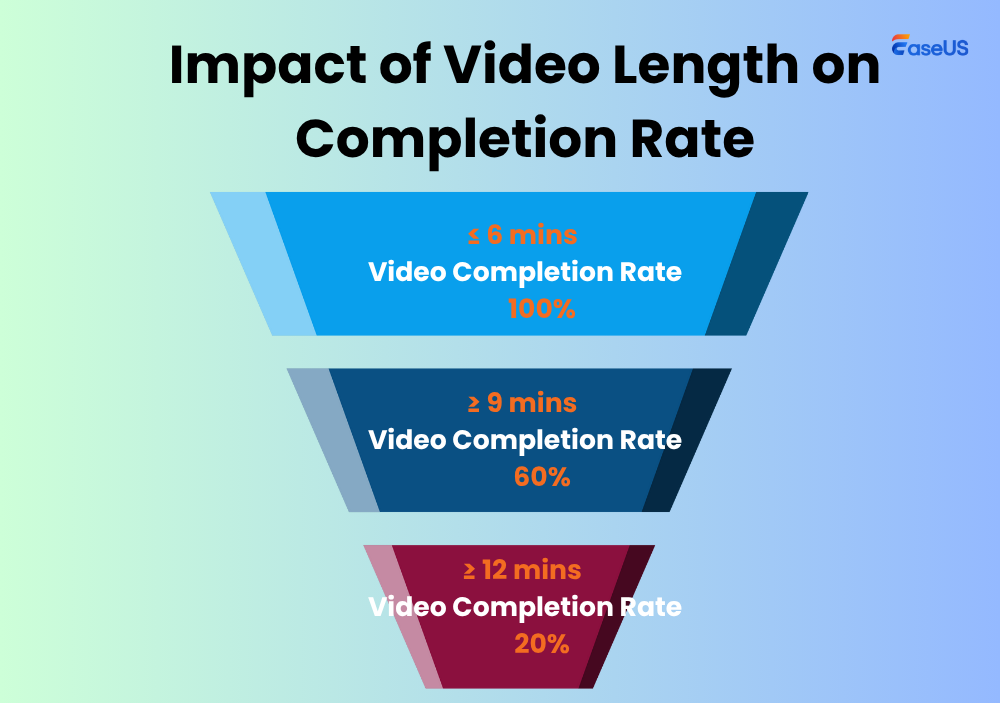
✅Microlearning Growth on Professional Platforms
Microlearning has become the dominant consumption model for adult learners and professionals.
- Coursera expanded its Clips offering with nearly 200,000 short lessons designed for rapid skill acquisition in the workforce. (Coursera Blog, 2022)
- edX emphasizes micro-credentials and targeted courses from top universities, blending academic rigor with practical, job-relevant skills. (Future Education Magazine, 2024)
- Platforms like Udemy and Skillshare have similarly seen significant growth in demand for concise, highly targeted courses.
✅Resurgence of Long-Form Learning Content
Despite the growth of short-form videos, long-form educational content is experiencing a parallel surge.
- Learners increasingly seek deep-dive learning experiences for mastering complex topics or professional certifications.
- The growing demand for more meaningful and in-depth content is fueling the comeback of long-form video. 54% of consumers prefer video content from brands they support, with many gravitating toward videos exceeding two minutes in length. (Hubspot, 2019)
4.2 Evolution of Content Formats
The design, delivery, and consumption of educational videos have transformed rapidly, driven by the demand for more interactive, efficient, and personalized learning experiences.
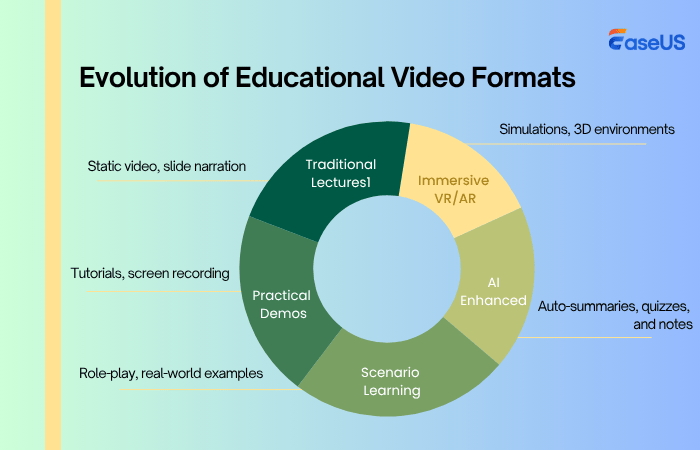
✅From Static Lectures to Immersive Learning
Educational content is moving beyond static formats. Traditional lectures are evolving into practical demonstrations, scenario-based lessons are becoming immersive experiences, and static videos are now interactive.
Today's videos often include chapter navigation, quizzes, note-taking tools, AI summaries, and real-time feedback, turning passive watching into active learning.
✅Rise of Multi-modal Content Consumption
To accommodate different learning preferences, video content is frequently paired with complementary resources:
- Video + Text Summaries + AI-Generated Notes for quick reviews.
- Video + Downloadable Slides + PDFs for reference.
- Video + Interactive Exercises or Coding Sandboxes for applied learning.
- Video + Peer Discussions through integrated community forums.
✅AI-Driven Enhancements in Learning
AI technologies are transforming video-based learning through:
- Automated Summarization (e.g., YouTube summaries, Coursera AI notes).
- Semantic Video Search enables learners to jump directly to relevant topics within a video.
- AI Note-Taking & Highlight Extraction to streamline review processes.
- Real-Time Translation and Auto-Subtitling, enhancing accessibility for global learners.
4.3 Shifting User Needs
As video-based education becomes the default medium for learning, user expectations have shifted dramatically toward greater speed, flexibility, personalization, and productivity integration.
✅From Knowledge Acquisition → Problem Solving → Productivity Enablement
- Past: Learners consumed videos primarily for passive knowledge absorption.
- Now: Video learning serves as a direct productivity tool, helping users solve immediate problems, accelerate workflows, and apply knowledge in real-time.
Core User Priorities in 2025
| User Need | Behavior / Expectation |
|---|---|
| Efficiency | Playback speed control, chapter navigation, semantic search |
| Flexibility | Replayable, on-demand, modular content |
| Productivity Support | Videos double as tools: AI summaries, searchable transcripts |
| Note-Taking | Built-in notes, downloadable highlights, AI-assisted annotations |
| Microlearning Focus | Short, actionable videos for immediate problem-solving |
✅The Blurring Line Between Learning and Doing
Learning is no longer a separate task from work. Professionals integrate video learning directly into their workflows.
Videos are now expected to function like interactive productivity tools, offering:
- Searchable content
- AI-driven highlights
- Copyable code snippets or resources
- Community-based feedback loops
5. Emerging Trends in eLearning Video Consumption
Looking ahead, eLearning video consumption is entering a new era, driven by AI, interactivity, and shifting learner expectations. The trends explored below highlight how the future of digital education is being reshaped by intelligent content creation, immersive technologies, and platform evolution.
5.1 AI-Generated Educational Content Will Scale Rapidly
Artificial intelligence is revolutionizing the creation, consumption, and personalization of educational videos. AI-powered video generation tools now enable educators and platforms to produce explainer videos, course modules, and language learning content in a fraction of the time it used to take. According to Fortune Business Insights (Fortune, 2025), the global market for VR in education is expected to surge from $17.18 billion in 2024 to $65.55 billion in 2032, following an annual growth rate of 18.2%, up from $14.55 billion in 2023.
Applications in education include:
- AI avatars as virtual instructors.
- Automatic transcription, subtitling, and multi-language voiceovers.
- Adaptive video content based on user behavior and learning progress.
These tools reduce production costs, expand global reach, and enable highly personalized learning experiences.
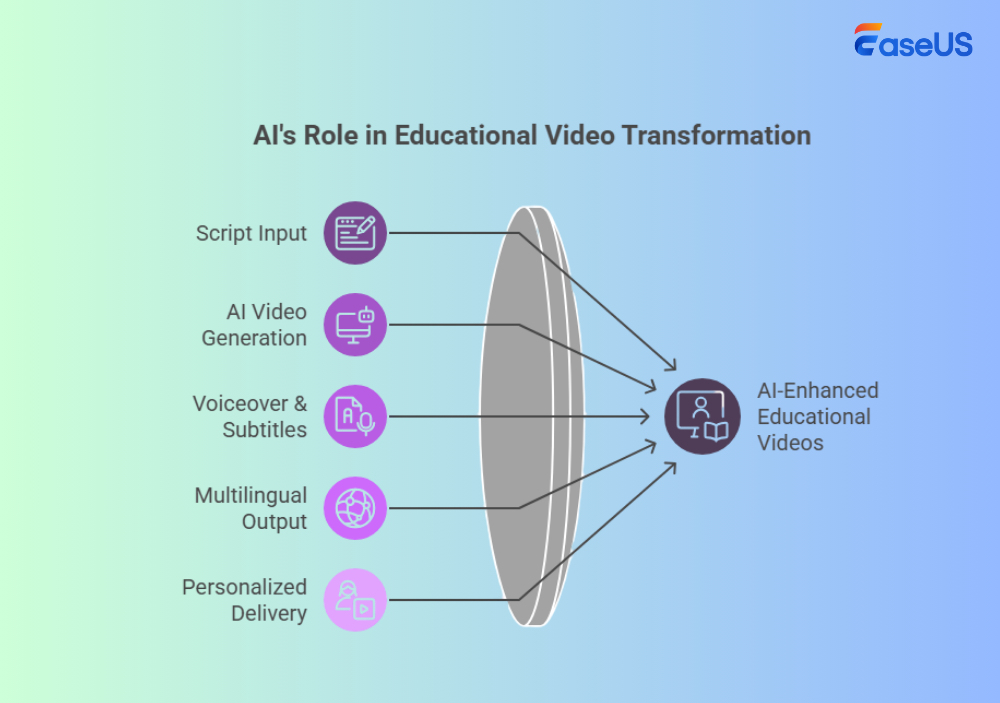
5.2 Interactive and Social Learning Experiences Are Gaining Ground
Video learning is evolving from passive consumption to active participation. As user expectations shift, platforms are increasingly integrating features that foster engagement, feedback, and collaboration.
Interactive learning experiences, such as real-time Q&A, in-video quizzes, and social learning communities, are no longer optional; they are becoming essential to keeping learners motivated and engaged.
Emerging patterns include:
- Live interaction and real-time knowledge checks
- Modular video navigation with personalized feedback
- Peer-driven learning spaces that encourage dialogue and co-creation
This trend is reshaping how both educational institutions and enterprises design video content, moving toward models that prioritize interaction, learner agency, and shared learning outcomes.
5.3 Creator Economy Fuels the Rise of Micro-Education Brands
Individual educators, freelance instructors, and subject matter experts are becoming powerful content creators. In 2025, the creator economy is valued at $224.2 billion and has already experienced rapid growth, with projections from Goldman Sachs suggesting it could reach $500 billion by 2027, driven by significant contributions from education-focused creators.
Key trends include:
- Instructors are monetizing through paid courses, memberships, and brand sponsorships.
- The emergence of "micro-education brands" led by individuals.
- Platforms like Udemy, Skillshare, and YouTube are enabling direct monetization tools.
This decentralization of education content is empowering niche educators to reach specific learner audiences and generate sustainable income streams. The implications are clear: as trust shifts from institutions to individuals, micro-education brands are becoming a powerful force in the future of learning.
5.4 Immersive Learning with VR/AR Enhances Practical Skills
Virtual Reality (VR) and Augmented Reality (AR) are evolving educational videos into deeply immersive, interactive learning environments. From virtual science labs to real-time language immersion, these technologies enable contextual, hands-on learning that goes far beyond traditional formats.
Core applications include:
- Simulated environments for STEM, healthcare, and vocational training
- Virtual classrooms and collaboration spaces for remote or hybrid learning
- Cross-device access that supports flexible, location-agnostic instruction
Although still in early stages of adoption, immersive learning is increasingly seen as a key enabler of high-impact, skills-based education models. As cost barriers decrease and platform support expands, these technologies are expected to move from experimental to essential.
Conclusion
Educational videos are no longer just supplementary learning tools, and they have become a core medium for knowledge delivery, skill development, and continuous learning across all age groups and industries. The shift toward interactive formats, immersive experiences, and creator-driven micro-education reflects a broader demand for flexible, efficient, and personalized learning.
These evolving consumption patterns are not only reshaping how learners engage with content but also creating new opportunities for technology providers to support, scale, and empower this transformation.
As a brand long rooted in data recovery, backup, and digital content protection, EaseUS is now expanding its product landscape into video-centric solutions, helping users record, organize, and retain knowledge more intuitively. Starting from screen recording and content transcription, EaseUS is expanding into broader video-centric use cases, exploring areas such as lecture capture, hybrid meeting workflows, and scalable e-learning content creation, to support the new age of visual-first education.
We believe that as the world learns more through video, creators and learners alike will need tools that are not only powerful and efficient, but also trustworthy and secure, values at the heart of the EaseUS ecosystem.
Know someone in education or content creation? Pass this along and inspire action.
Was This Page Helpful?
